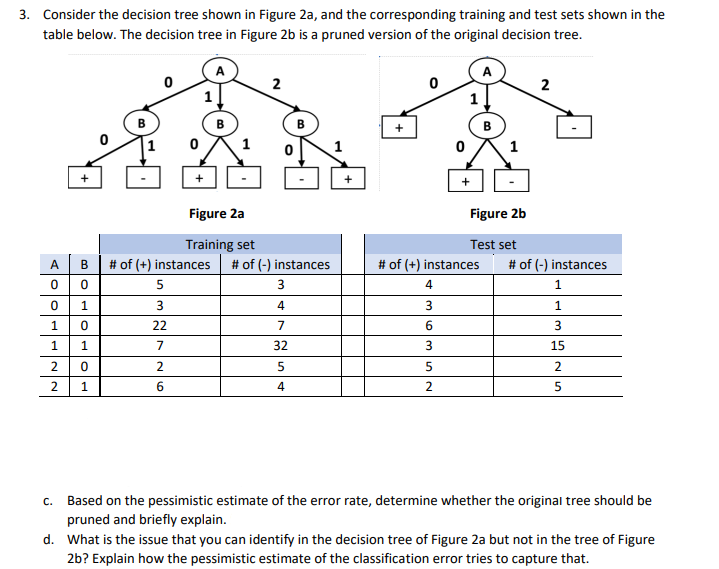3. Consider the decision tree shown in Figure 2a, and the corresponding training and test sets shown in the table below. The decision tree in Figure 2b is a pruned version of the original decision tree. 2 2 B Figure 2a Figure 2b Training set Test set A. B # of (+) instances # of (-) instances # of (+) instances # of (-) instances 5 3 4 1 1 3 4 3 1 22 7 1. 7 32 3 15 2 5 2 1 6 2 5 c. Based on the pessimistic estimate of the error rate, determine whether the original tree should be pruned and briefly explain. d. What is the issue that you can identify in the decision tree of Figure 2a but not in the tree of Figure 2b? Explain how the pessimistic estimate of the classification error tries to capture that.
3. Consider the decision tree shown in Figure 2a, and the corresponding training and test sets shown in the table below. The decision tree in Figure 2b is a pruned version of the original decision tree. 2 2 B Figure 2a Figure 2b Training set Test set A. B # of (+) instances # of (-) instances # of (+) instances # of (-) instances 5 3 4 1 1 3 4 3 1 22 7 1. 7 32 3 15 2 5 2 1 6 2 5 c. Based on the pessimistic estimate of the error rate, determine whether the original tree should be pruned and briefly explain. d. What is the issue that you can identify in the decision tree of Figure 2a but not in the tree of Figure 2b? Explain how the pessimistic estimate of the classification error tries to capture that.
Computer Networking: A Top-Down Approach (7th Edition)
7th Edition
ISBN:9780133594140
Author:James Kurose, Keith Ross
Publisher:James Kurose, Keith Ross
Chapter1: Computer Networks And The Internet
Section: Chapter Questions
Problem R1RQ: What is the difference between a host and an end system? List several different types of end...
Related questions
Question

Transcribed Image Text:3. Consider the decision tree shown in Figure 2a, and the corresponding training and test sets shown in the
table below. The decision tree in Figure 2b is a pruned version of the original decision tree.
2
1
+
Figure 2a
Figure 2b
Training set
Test set
A
B
# of (+) instances
# of (-) instances
# of (+) instances
# of (-) instances
3
4
1.
1.
4
1
1
22
7
6.
1
7
32
15
2
2
2
1.
4
2
c. Based on the pessimistic estimate of the error rate, determine whether the original tree should be
pruned and briefly explain.
d. What is the issue that you can identify in the decision tree of Figure 2a but not in the tree of Figure
2b? Explain how the pessimistic estimate of the classification error tries to capture that.
Expert Solution
This question has been solved!
Explore an expertly crafted, step-by-step solution for a thorough understanding of key concepts.
This is a popular solution!
Trending now
This is a popular solution!
Step by step
Solved in 3 steps with 3 images

Recommended textbooks for you

Computer Networking: A Top-Down Approach (7th Edi…
Computer Engineering
ISBN:
9780133594140
Author:
James Kurose, Keith Ross
Publisher:
PEARSON

Computer Organization and Design MIPS Edition, Fi…
Computer Engineering
ISBN:
9780124077263
Author:
David A. Patterson, John L. Hennessy
Publisher:
Elsevier Science

Network+ Guide to Networks (MindTap Course List)
Computer Engineering
ISBN:
9781337569330
Author:
Jill West, Tamara Dean, Jean Andrews
Publisher:
Cengage Learning

Computer Networking: A Top-Down Approach (7th Edi…
Computer Engineering
ISBN:
9780133594140
Author:
James Kurose, Keith Ross
Publisher:
PEARSON

Computer Organization and Design MIPS Edition, Fi…
Computer Engineering
ISBN:
9780124077263
Author:
David A. Patterson, John L. Hennessy
Publisher:
Elsevier Science

Network+ Guide to Networks (MindTap Course List)
Computer Engineering
ISBN:
9781337569330
Author:
Jill West, Tamara Dean, Jean Andrews
Publisher:
Cengage Learning

Concepts of Database Management
Computer Engineering
ISBN:
9781337093422
Author:
Joy L. Starks, Philip J. Pratt, Mary Z. Last
Publisher:
Cengage Learning

Prelude to Programming
Computer Engineering
ISBN:
9780133750423
Author:
VENIT, Stewart
Publisher:
Pearson Education

Sc Business Data Communications and Networking, T…
Computer Engineering
ISBN:
9781119368830
Author:
FITZGERALD
Publisher:
WILEY